Jari Arkko and Hui Deng
On November 5-6 a workshop was held in Shanghai to discuss the use of IPv6 in cellular networks. The workshop was hosted by China Mobile, chaired by Hui Deng (China Mobile), Jonne Soininen (NSN), and Jari Arkko (Ericsson) and there were around 70 participants. Most of the participants were from the network equipment vendor and cellular operator communities. The workshop was also expected to provide background information relating to the 3GPP study item regarding IPv6 transition and an upcoming joint meeting between IETF and 3GPP.
The workshop included demonstrations, presentations of product readiness from vendors, discussions of requirements and deployment scenarios, and presentations of IPv6 transition tools. The participants learned a lot about the problems, needs and opportunities involving IPv4-IPv6 co-existence and IPv6 transition.
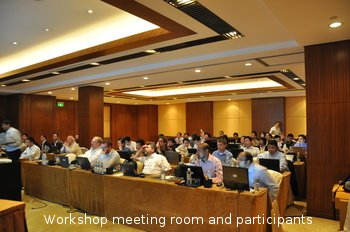
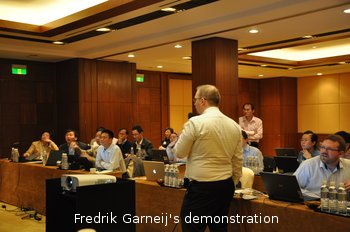
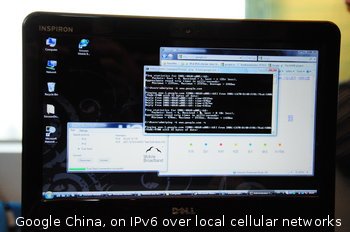
The baseline IPv6 support model for 3GPP cellular networks -- dual stack -- is clear in current specifications, widely supported in products, and to a large extent ready to be just used. Recently added support for IPv6 in major content provider networks (e.g., Google over IPv6) makes it possible to leverage IPv6 to offload IPv4 communications and NATs -- today. This was even demonstrated during the workshop using commercial networks and devices. There is wide agreement that the standard dual stack model is the first necessary step in IPv6 adoption in cellular networks, though certainly not the last step.
Some of the basic scenarios that were discussed in the workshop were: (1) Employing IPv6 in the transport network underneath, i.e., for signaling and tunneling. This use of IPv6 is independent of what IP version actual user traffic employs. (2) Employing IPv6 for operator services. In operator services there is more freedom to employ particular technical solutions (such as IPv6), as there is no requirement for, e.g., web sites on the other side of the Internet to use exactly the same solutions. However, roaming of such services may require additional work. (3) Employ dual stack IPv6 to off-load some IPv4 traffic to IPv6 where supported by content providers. Some additional scenarios that may require further work included (1) Broadband cellular connections can be used as an alternative to, e.g., DSL lines. In some cases there is a need to share such a connection among multiple computers. In IPv4 this functionality is achieved via a NAT, but current 3GPP specifications lack an alternative solution for IPv6-based devices. (2) Connecting IPv6-only networks to both IPv4 and IPv6 Internet. (3) Connecting IPv4-only devices to IPv6 servers. (4) Moving NAT functionality from multiple GGSNs to a centralized gateway. (5) Enabling IPv4-only applications to exist in IPv6-only cellular networks.
The workshop discussed a number of IPv6 transition tools that either already exist or are under development (dual stack, 6to4, 6rd, dual stack lite, gateway initiated dual stack lite and other tunneling tools, nat64, ivi, pnat and other translation tools). It is important to understand how each tool fits a specific network scenario. Dual stack continues to be main recommended IETF deployment tool for networks transitioning to IPv6, even if there are many situations where additional tools are needed. Ongoing work in the IETF BEHAVE and SOFTWIRE working groups develops these tools, and feedback regarding the toolset should be taken there. It was also noted that after extensive analysis, the IETF chose to employ tunneling for for IPvX to IPvX communications over IPvY networks, instead of using double translation. Translation based mechanisms are used for IPvX to IPvY communications. This is reflected in the charters and working group outputs of BEHAVE and SOFTWIRE. The analysis conclusions are not universally shared, however, and there are proposals for new mechanisms that fall outside the currently recommended IETF model (e.g., proposals involving double translation).
The workshop also identified missing pieces and further actions. The following next steps were identified:
1. Work on the actual transition mechanisms is an IETF activity, and the IETF is happy to receive input regarding the industry needs for IPv6 transition. The IETF meeting on the following week was an opportunity to voice the participants' technical input on existing transition tools and possible additional requirements.
2. IPv6 should be turned on in the participants' networks in order to start the necessary learning of the operational issues and to generate actual IPv6 traffic. The workshop demos showed that this can be done today -- though perhaps done best in a step-wise manner to avoid surprises. It is very important that the experiences from the deployment effort are shared within the cellular operator community. We'd like to hear more success stories and share experiences. We'd like to hear more about actual progress and less about things that might be done far in the future.
3. Additional focus is needed for generating actual IPv6 traffic towards the Internet. While the internal link layer, tunneling, and translation operations within the cellular networks are important, at the end of the day the most important issue is whether the entire system -- including, for instance, content providers and other Internet infrastructure works together to actually make use of these facilities.
4. Further input on operator requirements from a larger number of mobile operators is necessary. The work on scenarios in 3GPP study item needs to continue. It is important to understand the priority of the different scenarios; it does not make sense to create technical solutions for all possible situations, it is more important to focus on the most important ones. It is also important think about the deployment process a set of steps. There is no one end goal -- but there steps you need to take to move to the right direction.
5. The chairs of the workshop will provide a summary of discussions. Slides presented in the workshop will be made available (where the organizers have been given a permission to do so, which we expect to be the case for most of the material).
6. A mailing list will be created for the workshop participants and other interested parties to continue discussion.
7. China Mobile announced that they are sponsoring the 2010 March official 3GPP-IETF official IPv6 workshop. Discussions about the content and goals of this joint workshop will be discussed further in the IETF and 3GPP.
In "IPv6 deployment scenarios in cellular networks", Jari Arkko (Area Director at the IETF, Ericsson) described the current state and remaining work in IPv6 deployment in cellular networks. The tools to use IPv6 exist today in most cellular networks, and the primary obstacles ahead of deployment are turning the IPv6 support on in the networks and finding traffic that can employ IPv6. Given Google over IPv6 and other tools from major content providers, during 2009 it has become possible to move significant fraction of Internet traffic to IPv6 simply by enabling IPv6 in the network. Jari also discussed the primary deployment scenarios that he sees in the short, term, namely making the underlying transport network IPv6-only, IPv4-offload via dual stack, and operator services via IPv6.
In "IPv6 migration study item in 3GPP", Lianyuan Li (China Mobile) provided an overview of the current state of the 3GPP architecture work and most relevant interfaces where IP is used. On the second half of the presentation he covered scenarios for IPv6 migration that have been identified so far by 3GPP.
In "IPv6 migration scenarios for Orange", Julien Bournelle (Orange) covered two scenarios for IPv6 deployment. The first one involves an IPv4-only host that needs to contact IPv6 services. The second one involves a dual stack host which has only IPv6 connectivity, but needs to connect to IPv4 services as well.
In "IPv6 transition work at the IETF", Ralph Droms (Area Director at the IETF, Cisco) discussed past and current IETF work around IPv6 transition. The primary recommend tools for IPv6 deployment have not changed even if a number of new tools have been developed. Dual stack is the most well-understood way to deploy IPv6 today. New tools under development in the SOFTWIRE WG include dual stack lite and 6rd. The first of these tools covers scenarios where a service provider employs an IPv6-only core network while still having to provide customers legacy IPv4 service. The second tools covers scenarios where a service provider wants to provide IPv6 service without deploying IPv6 in its core network.
In "IPv6 support in today's cellular network equipment" Fredrik Garneij (Ericsson) demonstrated that IPv6 is reality already today in the cellular networks and Dual-Stack can be turned on already today by flipping a switch. IPv6 dual-stack demo while roaming on a regular commercial cellular network in China with dual stack, existing cellular standards, off the shelf devices (Dell laptop with dell branded Ericsson MBM), commercial home operator service in Sweden, and Google over IPv6.
In "IPv6 deployment in operator's network", Dean Cheng (Huawei) argued that every provider has different situation and may need different tools. He discussed tools that may address two distinct scenarios. The first scenario relates to providing IPv6-only service in the network but still allowing access to the IPv4 Internet. The second scenario relates to the use of carrier-grade NAT device for IPv4 while offering early adopters tunnel-based IPv6 service.
In "IPv6 support in 3GPP networks", Basavaraj Patil and Sherry Shen (Nokia & NSN) explained the current level of IPv6 support in their products at a detailed level. Most of the new terminal platforms support IPv6 in dual stack mode. They are considering the possible inclusion of additional tools based on market demand.
In "China Mobile IPv6 scenarios and PNAT solution", Hui Deng (China Mobile) explained a proposed new transition tool, PNAT, and discussed the gap analysis regarding existing tools. The primary goal is to employ IPv6-only networks while still supporting IPv4-only applications and host-to-host direct communication. Some existing applications cannot work in IPv6 environments if they do not employ IP-version agnostic APIs. PNAT is compatible with NAT64 but moves a little further to support IPv4 applications. However, the focus is on hosts that can be upgraded to support new functionality below the application layer.
In "The view from IPv6 Operations WG", Fred Baker (IETF V6OPS WG chair, Cisco) talked about the goals of IPv6 transition work as it had been analyzed by the IETF. He pointed out that it is most important to get IPv6 turned on for networks, and that attempting to optimize the behavior for remaining IPv4-only device is less important and can be harmful for the overall goal. Fred also explained the analysis work that the IETF had performed on different types of solutions involving IPvX nodes reaching IPvX nodes through a network of IPvY. From the point of view of enabling connectivity, reliability, and ability to diagnose problems the IETF has made a decision that designs based on two translation steps are inferior compared to designs based on tunneling. There are no plans to provide any transition tools involving two translation steps. Translation based designs are important for reaching IPvX from IPvY, however, and are worked in the BEHAVE WG. Tunneling based designs are worked on SOFTWIRE WG. Some workshop participants challenged the need to restrict designs to one-step only translation.
In "DS-Lite: Implementation experience and views", Basavaraj Patil (Nokia) explained what experiences the Nokia and NSN team had gotten from an implementation of dual stack lite on top of Maemo Linux and N810.
In "Mobility considerations for transition technologies", Sri Gundavelli (Cisco) provided a technical comparison of different transition techniques. The main conclusion was that no silver bullet exists but there are differences in which scenarios different tools cover.
In "DSMIP6 as a transition solution", Basavaraj Patil (Nokia) explained how dual stack Mobile IP (DSMIP) can work as a transition tool. DSMIP is a part of existing specifications for 3GPP Release 8 mobility support. No support is required from the access network to use DSMIP.
In "NAT64 and Implementation", Simon Perreault (Viagenie) explained his experiences about implementing NAT64, one of the solutions developed in the BEHAVE WG at the IETF.
In "IPv4 to IPv6 transition approaches", Hu Jun (Alcatel-Lucent) covered various requirements for transition to IPv6. It was suggested that known, well understood and widely available tools such as dual stack and plain old IPv4 NATs are preferable to new tools such as address family translation (NAT64, for instance).
In "The service delivery aspects of IPv6 migration and E.164 convergence", Alan Lloyd (Wwite) noted that operations and management can be a significant aspect of the IPv6 transition. IP addresses are now used as a part of the service offering (setting policies, charging, etc) and many backend systems may need to take into account the use of IPv6 addresses. He provided practical guidance on how the transition should be performed in order to avoid unexpected effects in services or infrastructure components such as DNS and DHCP servers.
In "IPv6 Support on Qualcomm Platforms" Julien Laganier (Qualcomm) information about IPv6 support in Qualcomm products was provided. As with other vendors, the basic functionality is support for the existing 3GPP and IETF specifications, i.e., dual stack IPv4 and IPv6 operation.
In "IPv6 Transition In Cellular Networks", Christian Vogt (Ericsson) presented ongoing work regarding the requirements and barriers of IPv6 deployment in mobile operators networks.
In "IPv6 in Mobile Networks" Rajeev Koodli (Starent Networks) illustrated different IPv6 transition points and the constraints imposed by mobility, such as roaming and handover to 3G. The presentation also discussed the applicability of IPv6-IPv4 transition mechanisms, as well as IPv6 support in Starent mobility gateways.
The workshop also hosted a vendor panel discussion between Fred Baker (Cisco), Parviz Yegani (Juniper Networks), Fredrik Garneij (Ericsson), Basavaraj Patil (Nokia), Tony Xia (Huawei), Zaifeng Zong (ZTE, presentation), Rajeev Koodli (Starent), and Julien Laganier (Qualcomm). The main focus of the questions from the audience was operational advice on moving to IPv6. The panelists emphasized the need to make a step-wise approach. For instance, it is necessary to operate both IPv4 and IPv6 in parallel, and to move small parts of networks (e.g., one APN) at a time to IPv6.
The workshop included three demonstrations: current IPv6 support (Fredrik Garneij), PNAT (Hui Deng), and DS-Lite (Basavaraj Patil). The current IPv6 support demonstration showed how existing cellular networks already support IPv6 and how traffic to global content providers can already be moved to IPv6 today. DS-Lite demonstration showed an existing devices that can operate in IPv6-only networks while supporting both IPv4 and IPv6 Internet connectivity. PNAT demonstration showed that with just a small implementation effort, the use of NAT64, and an additional module installation on a host support for IPv4-only application can be added to IPv6-only networks.
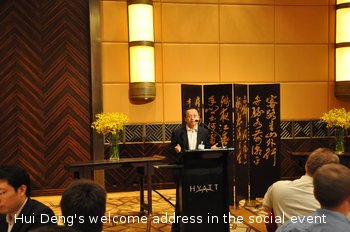

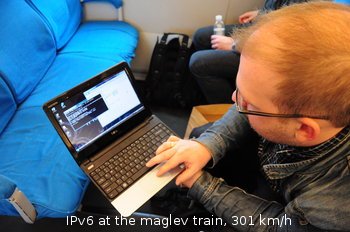
At the end of the workshop, the chairs summarized the results. The workshop also included a social event sponsored by China Mobile.